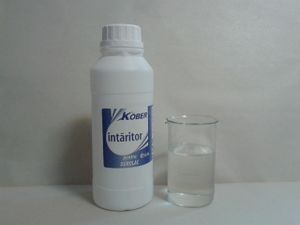Butanol
 n-Butanol obtained from acid curing parquet varnish.
| |
| Names | |
|---|---|
| IUPAC name
1-Butanol
| |
| Systematic IUPAC name
Butan-1-ol | |
| Other names
n-Butyl alcohol
| |
| Properties | |
| C4H10O | |
| Molar mass | 74.12 g/mol |
| Appearance | Colorless liquid |
| Odor | Strong, banana-like, unpleasant |
| Density | 0.81 g/cm3 |
| Melting point | −89.8 °C (−129.6 °F; 183.3 K) |
| Boiling point | 117.7 °C (243.9 °F; 390.8 K) |
| 6.8 g/100 ml (25 °C) | |
| Solubility | Miscible with acetone, diethyl ether, ethanol, isopropanol, methyl ethyl ketone |
| Vapor pressure | 6 mmHg (20 °C) |
| Thermochemistry | |
| Std molar
entropy (S |
225.7 J·K−1 mol−1 |
| Std enthalpy of
formation (ΔfH |
−328(4) kJ/mol |
| Hazards | |
| Safety data sheet | Sigma-Aldrich |
| Flash point | 35 °C |
| Lethal dose or concentration (LD, LC): | |
| LD50 (Median dose)
|
790 mg/kg (rat, oral) |
| Related compounds | |
| Related compounds
|
Propanol Pentanol |
| Except where otherwise noted, data are given for materials in their standard state (at 25 °C [77 °F], 100 kPa). | |
| Infobox references | |
Butanol, also known as 1-butanol, n-butanol, n-butyl alcohol or normal butanol is a straight-chain primary alcohol with the chemical formula CH3(CH2)3OH or C4H9OH. Its isomers include isobutanol, sec-butanol, and tert-butanol.
The term butanol is generally accepted only for the n isomer.
Contents
Properties
Chemical
Butanol is commonly used for the production of butyl esters, especially butyl acetate and butyl butyrate, used in the pharmaceutical and food industry.
Butanol will burn to release carbon dioxide, water and heat.
- C4H10O + 6.5 O2 → 4 CO2 + 5 H2O
Physical
Butanol is a colorless viscous liquid, with a unique, unpleasant, fruity like odor, reminiscent of bananas. It is moderately soluble in water (73 g/L at 25 °C), but miscible with organic solvents such as acetone, ethanol, ethyl acetate. It boils at 117.7 °C and melts at −89.8 °C. Butanol has a density of 0.81 g/cm3.
Availability
Butanol is available as car fuel, though it may contain other isomers depending on the product. Since it has low toxicity and relative high flash point, it can be readily found online, on eBay and Amazon.
Butanol can also be found in some acid curing lacquer/varnish or wood paint drying accelerators (most often for parquet). They tend to contain 7% HCl, that will require neutralization. Be sure to read the label carefully before using, as not all products have n-butanol, some may have isobutanol instead.
Like butyl acetate, butanol is often encountered in many OTC solvents/paint thinners as diluting agent, and its presence may affect various chemical reactions done in said solvents. Xylene also appears in some butanol-containing products.
Preparation
There are several ways to prepare butanol. One way is to hydrolyze or decarboxylate butyl esters, such as butyl acetate or the industrially available dibutyl phthalate. Another involves the hydrolysis of halogenated butyl compounds.
It can also be produced via the ABE process, a biochemical route involving the use of anaerobic fermentation of sugars by any of several bacteria. This process takes place in aqueous solution and typically yields 3 parts acetone, 6 parts butanol and 1 part ethanol, albeit at a low concentration.
Industrially it is produced from propylene, that is hydroformylated and then hydrogenated to give butanol.
Due to the specialized nature and difficulties of the above routes, it is typically more economical to simply purchase the alcohol.
Projects
- Butyl acetate synthesis
- Butyric acid synthesis
- 1-chlorobutane synthesis
- Biofuel
- Recrystallizing organic compounds
- THF synthesis
Handling
Safety
Butanol is readily absorbed through the intestinal tract and lungs, and also to some extent through the skin. It is extremely irritating to the eyes; repeated contact with the skin can also cause irritation. This is believed to be a generic effect of "defatting". The acute toxicity of butanol is relatively low, with oral LD50 values of 790–4360 mg/kg (for rat), while for ethanol are 7000–15000 mg/kg). No deaths were reported at an inhaled concentration of 8000 ppm (4-hour exposure, rats).
With a flash point of 35 °C, butanol presents a moderate fire hazard. It is slightly more flammable than diesel or kerosene fuel but less flammable than many other common organic solvents. It still requires preheating to ignite, if its temperature is below 35 °C.
Storage
Butanol should be stored in closed bottles, away from any open flames or oxidizers. Since its strong odor may be annoying to many people, it's best to keep it in a solvent cabinet, in a well ventilated area.
Do not keep butanol in moldy or damp places, as its vapors will be converted by the microorganisms to butyric acid, giving the room an unpleasant cheese-like odor.
Disposal
Butanol can be safely burned, as it produces no hazardous products. Due to its relative high flash point, it's a good idea to mix it with a more flammable solvent, before burning it.